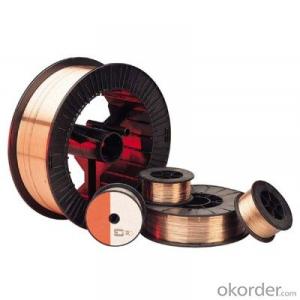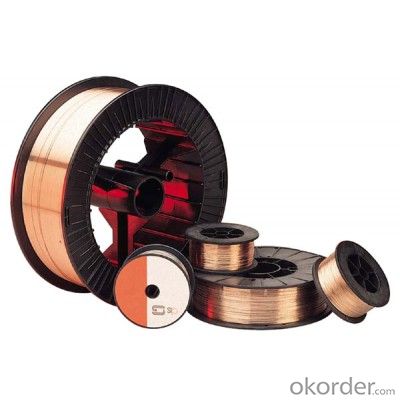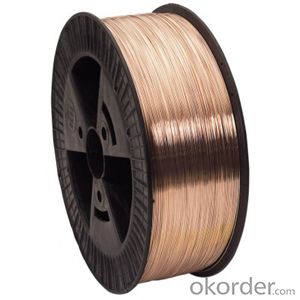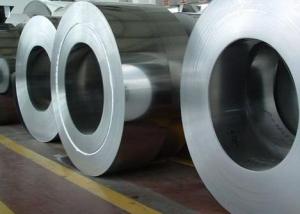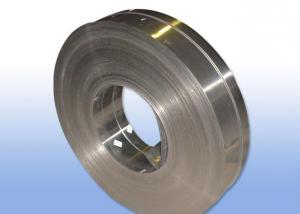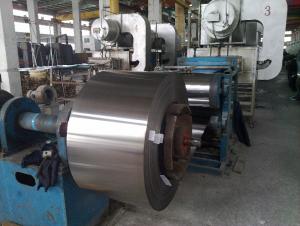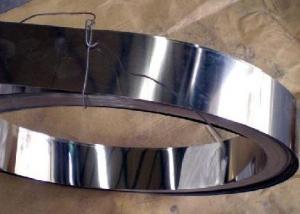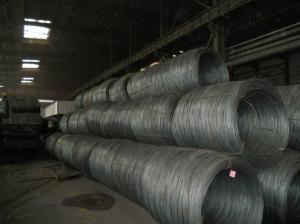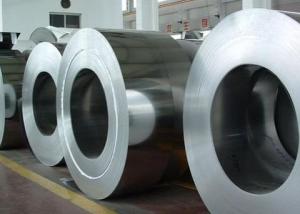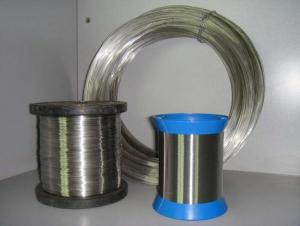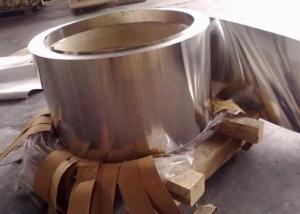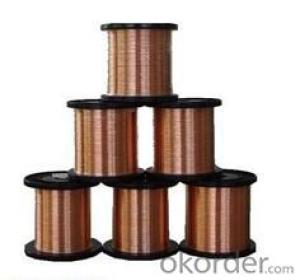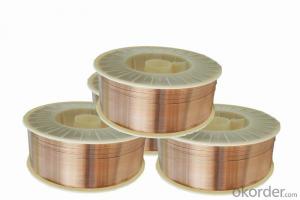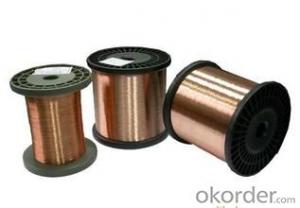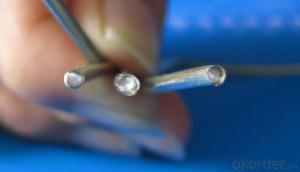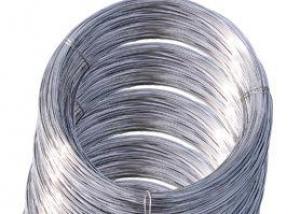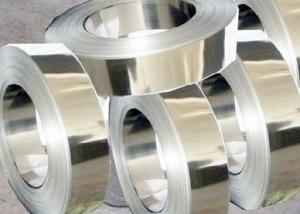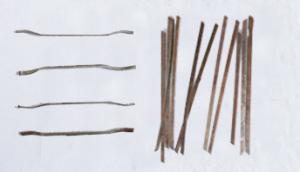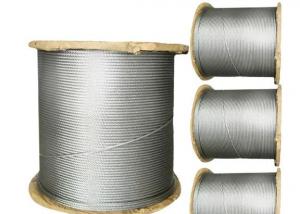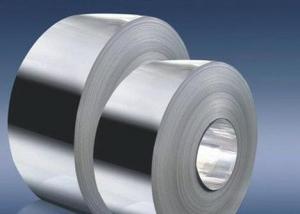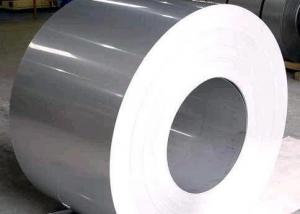MANGANESE STEEL WELDING WIRE WITH COPPER COATED
- Loading Port:
- Qingdao
- Payment Terms:
- TT OR LC
- Min Order Qty:
- 10 m.t.
- Supply Capability:
- 1000 m.t./month
OKorder Service Pledge
OKorder Financial Service
You Might Also Like
Specifications
All products of welding wire were produced by German equipment.
Advanced technologies with advanced equipment.
Gas-shielded welding wires utilize Co2,argon-rich gas and argon gas as the shielding gases with high production efficiency.Large current may be used during welding to achieve droplet transfer,wiht large melting coefficient of wire, excellent depth of welding penetration on material, little melting residues,high-density current, concentrated heat, small heating area, little distortion of work pieces after welding, etc.
Because of low content of hydrogen in the seam,cold cracking is rare. Good visibility of electric arc facilitates full-position welding and welding at other positions.
Main Applications:Welding of various 500Mpa structural steel components;welding of various 500Mpa plates and pipes;full-position welding with a wide range of current.
Chemical Compositions of one sample wire(%)
C 0.07 Mn1.47 Si0.86 P0.012 S0.010
Mechanical Properties
Gas: Co2
Yiels strength(Mpa): 467
Tensile strength(Mpa): 542
Elongation(%): 26
Impact Energy(J): 101(-30°c)
- Q: Can stainless steel wire be used for wire ropes in elevators?
- Yes, stainless steel wire can be used for wire ropes in elevators. Stainless steel wire ropes are commonly used in elevators due to their high strength, corrosion resistance, and durability.
- Q: What are the different tensile strengths available for stainless steel wire?
- The tensile strengths available for stainless steel wire vary depending on the specific grade and thickness of the wire. Some common tensile strengths for stainless steel wire range from 70,000 to 300,000 pounds per square inch (psi).
- Q: How flexible is stainless steel wire?
- Stainless steel wire is known for its remarkable flexibility. Due to its composition, which includes a high amount of chromium, stainless steel wire has excellent tensile strength and can be bent and twisted without breaking or losing its shape. It can be easily coiled, wrapped, or shaped into various forms, making it highly versatile for a wide range of applications. Furthermore, stainless steel wire retains its flexibility even in extreme temperatures, making it suitable for both indoor and outdoor use. This flexibility allows stainless steel wire to be used in industries such as construction, automotive, aerospace, and medical, where it can be utilized for purposes like wire rope, mesh screens, springs, and electrical wiring. Overall, stainless steel wire offers excellent flexibility, making it a reliable and preferred choice for many applications.
- Q: 202 stainless steel wire can pass 200 hours salt mist test?
- Stainless steel passivation liquid has a strong advantage:First, the passivation does not change any size and color of the workpiece, effectively protect the beautiful appearance and accuracy of the workpiece.Two, the use of low cost, liquid drugs can be reused, the realization of material rust grade by sub strong (201 change 304, 304 change 316) Enhance the added value of products and effectively reduce the cost of enterprises.Three, after passivation, corrosion resistance is strong, 201 series of materials through more than 48 hours, 304 series of materials 200~1500 hours, salt fog test.Four, simple operation, stainless steel passivation liquid performance is stable, only need to soak at room temperature.
- Q: What are the different types of stainless steel wire for different levels of corrosion resistance?
- There are several types of stainless steel wire available, each offering varying levels of corrosion resistance. Some common types include 304 stainless steel wire, which provides good corrosion resistance in general applications; 316 stainless steel wire, known for its excellent resistance to corrosion in marine environments and high chloride environments; and 430 stainless steel wire, which is less corrosion resistant but suitable for less demanding applications.
- Q: Can stainless steel wire be used for springs in the agricultural industry?
- Yes, stainless steel wire can be used for springs in the agricultural industry. Stainless steel is known for its high strength and corrosion resistance, making it suitable for various applications in agricultural machinery and equipment. The use of stainless steel wire for springs ensures durability and longevity, even in harsh agricultural environments where exposure to moisture, chemicals, and outdoor elements is common.
- Q: What are the different corrosion resistance levels of stainless steel wire?
- Stainless steel wire has different corrosion resistance levels depending on the specific grade and composition of the alloy. Generally, stainless steel wire can be classified into three main corrosion resistance levels: low, medium, and high. The low corrosion resistance level is typically associated with 400 series stainless steel, which contains less chromium and is more prone to corrosion in certain environments. The medium corrosion resistance level is found in 300 series stainless steel, which has a higher chromium content and offers better resistance to corrosion in many applications. The high corrosion resistance level is often attributed to specialized alloys such as 316 stainless steel, which contains additional elements like molybdenum, providing excellent resistance to corrosive agents such as acids and chloride solutions.
- Q: How are stainless steel wire mesh trays used in industrial drying?
- Stainless steel wire mesh trays are commonly used in industrial drying processes to provide a sturdy and efficient platform for drying various materials. They allow for proper airflow and heat distribution, ensuring uniform drying. The wire mesh design prevents the materials from falling through while allowing moisture to escape, facilitating the drying process. These trays are durable, easy to clean, and can withstand high temperatures, making them ideal for industrial drying applications.
- Q: What are the different tensile strength options available for stainless steel wire?
- Stainless steel wire is renowned for its remarkable strength and durability, making it a favored choice for a broad range of uses. The tensile strength of stainless steel wire pertains to its capacity to endure pulling forces without fracturing or distorting. When it comes to tensile strength for stainless steel wire, there are numerous alternatives available, each tailored to specific purposes and criteria. The most prevalent options for tensile strength in stainless steel wire encompass grades 304, 316, and 430. 1. Typically exhibiting a tensile strength of approximately 70,000 to 90,000 pounds per square inch (psi), grade 304 stainless steel wire offers exceptional resistance to general corrosion. This grade is well-suited for diverse applications, including wire mesh, springs, and fasteners. 2. Grade 316 stainless steel wire presents a higher tensile strength than grade 304, ranging from 80,000 to 100,000 psi. This grade showcases remarkable resistance to corrosion, particularly in marine environments or when exposed to chemicals or acidic substances. It finds common use in marine rigging, medical equipment, and industrial wire rope. 3. Grade 430 stainless steel wire possesses a lower tensile strength compared to grades 304 and 316, typically ranging from 55,000 to 75,000 psi. This grade is often employed in less demanding applications where primary concern does not lie in corrosion resistance. It is commonly utilized for decorative purposes, such as architectural wire mesh or jewelry. In addition to the aforementioned grades, various specialty stainless steel wires are available, each boasting different tensile strengths. These specialty wires are specifically designed for applications necessitating exceptional strength or resistance to extreme conditions. To summarize, the available options for tensile strength in stainless steel wire include grade 304, grade 316, grade 430, and various specialty wires. Understanding the specific requirements of your application will aid in determining the most suitable tensile strength option for your stainless steel wire needs.
- Q: What are the different types of stainless steel wire rope slings?
- In the market, there exists a variety of stainless steel wire rope slings, each designed to meet specific requirements and applications. Some common types include: 1. Single-leg slings: These slings consist of one stainless steel wire rope with a loop eye at one end and a hook or other attachment point at the other end. They are typically used for light to medium-duty lifting applications. 2. Double-leg slings: Similar to single-leg slings, these slings have two legs with loop eyes at both ends. They are commonly utilized for heavier loads or when additional stability is needed. 3. Triple-leg slings: These slings consist of three legs with loop eyes at both ends of each leg. They are suitable for lifting and securing heavy and bulky loads, providing increased stability and load distribution. 4. Multi-leg slings: These slings have more than three legs, typically four or more, and are employed for extremely heavy or irregularly shaped loads that require additional support and control. 5. Adjustable slings: These slings have a mechanism that allows for easy adjustment of the length of the legs. They are ideal for situations where the load height or distance varies. 6. Endless slings: Made from a continuous loop of stainless steel wire rope, these slings can be wrapped around the load in various configurations to securely lift odd-shaped objects. 7. Grommet slings: These slings are created by forming a loop at each end of the stainless steel wire rope and then attaching a master link or other fitting to create a secure lifting point. 8. Basket slings: These slings consist of a length of stainless steel wire rope formed into a loop with both ends connected to a master link or other attachment point. They are commonly used to lift loads with multiple attachment points or to provide a basket-like support. To ensure safe and efficient lifting operations, it is crucial to select the appropriate type of stainless steel wire rope sling based on the intended application, load capacity, and environmental conditions.
Send your message to us
MANGANESE STEEL WELDING WIRE WITH COPPER COATED
- Loading Port:
- Qingdao
- Payment Terms:
- TT OR LC
- Min Order Qty:
- 10 m.t.
- Supply Capability:
- 1000 m.t./month
OKorder Service Pledge
OKorder Financial Service
Similar products
Hot products
Hot Searches
Related keywords
